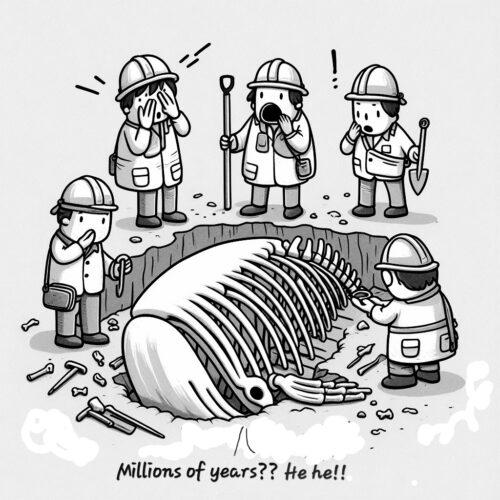Geologic Dating: Is It a Showstopper for Young Earth Science?
Are Millions of Years Written in Stone?
When you pick up a rock, you’re holding a piece of Earth’s history in your hands. But just how old is that history? While most geologists interpret the evidence to suggest Earth is billions of years old, a growing number of scientists are asking challenging questions about the assumptions underlying geological dating methods.
We acknowledge upfront the young Earth perspective represents a minority view within the scientific community. However, science progresses when researchers are willing to question established paradigms and examine the evidence from fresh angles.
Consider these puzzling observations that conventional geological timescales struggle to explain:
- Soft tissue preservation in dinosaur fossils, including flexible blood vessels and intact proteins
- Rapid formation of geological features that were thought to require millions of years
- The presence of short-lived carbon-14 in coal and diamonds supposedly millions of years old
- Bent rock layers showing evidence of deformation while still soft, rather than after hardening over millions of years
- The remarkable preservation of fossils, which typically requires rapid burial rather than slow accumulation of sediments
In this article, we shall explore how geological evidence can be understood through a different lens—one that suggests Earth’s major geological features formed through rapid, catastrophic processes rather than gradual accumulation over millions of years. We’ll focus on the scientific evidence and what it tells us about Earth’s history, examining both the strengths and limitations of various dating methods.
UNDERSTANDING THE CONVENTIONAL GEOLOGIC TIMESCALE
The conventional geological timescale, developed over centuries of scientific investigation, divides Earth’s history into major eras spanning billions of years. The system uses radiometric dating methods, index fossils, and stratigraphic principles to assign ages to rock layers and fossils. According to mainstream geology, Earth is approximately 4.54 billion years old, with life evolving over hundreds of millions of years.
The timescale divides Earth’s history into the Precambrian, followed by the Palaeozoic, Mesozoic, and Cenozoic eras. Each division shows distinct fossil assemblages and geological features, with increasingly complex life forms appearing in higher layers.
YOUNG EARTH REINTERPRETATION OF GEOLOGICAL EVIDENCE
From a young Earth perspective, we interpret these same geological features within a biblical framework that points to a much younger Earth, approximately 6,000-10,000 years old. This interpretation centres on two key historical events: the Creation Week and the global Flood described in Genesis.
The majority of Earth’s rock layers and fossils can be understood as the result of the global Flood—a catastrophic event that would have produced geological features in days or months that conventional geology attributes to millions of years. This catastrophic model explains several key observations:
- The rapid formation of rock layers during the Flood accounts for the remarkable preservation of fossils, which typically require quick burial to form.
- The ordered arrangement of fossils in rock layers can be explained by ecological zonation, mobility, and hydrological sorting during the Flood rather than evolutionary succession.
- Features like polystrate fossils (trees extending through multiple rock layers) and soft tissue preservation in dinosaur fossils suggest rapid burial and young ages rather than millions of years of slow deposition.
ADDRESSING THE SCIENTIFIC EVIDENCE
Radiometric Dating
While radiometric dating methods are often cited as proof of an old Earth, these methods rely on several unprovable assumptions:
- That initial conditions are known
- That decay rates have remained constant
- That systems have remained closed over time
Research by young Earth scientists, particularly through the RATE project (Radioisotopes and the Age of The Earth), has identified several challenges to conventional radiometric dating interpretations, including evidence for accelerated nuclear decay in the past and discordant dates from different methods applied to the same rocks.
Geological Formations
The Grand Canyon is as an excellent example of how geological features can be interpreted differently. Rather than representing millions of years of slow deposition and erosion, the Canyon’s layers can be understood as the result of rapid deposition during the Flood, followed by catastrophic erosion as floodwaters receded. The absence of significant erosion between layers supports this rapid deposition model.
Fossil Record
The fossil record, rather than showing gradual evolution over millions of years, can be interpreted as a record of the order in which pre-Flood ecosystems were buried during the Flood. Marine fossils found on mountaintops and the worldwide distribution of fossil layers provide evidence for this global catastrophic event.
CURRENT RESEARCH AND SCIENTIFIC WORK
Young Earth researchers continue to develop and refine scientific models that explain geological features within a biblical timeframe. These include:
- Catastrophic plate tectonics models that explain continental drift occurring rapidly during the Flood
- Hydrological models for the formation of sedimentary layers and erosional features
- Studies of radiometric dating and potential mechanisms for accelerated decay
- Research into the preservation of organic materials in fossils
IMPLICATIONS AND CONCLUSIONS
The young Earth interpretation of the geological timescale demonstrates it’s possible to understand scientific evidence within a biblical framework. The view maintains science and Scripture are complementary when properly interpreted, though this often requires challenging conventional assumptions about geological time.
While this perspective remains a minority view in the scientific community, it continues to develop through peer-reviewed research and scientific investigation. The ongoing work of creation scientists provides a framework for understanding Earth’s history that honours both the biblical account and the observable evidence.
LOOKING FORWARD
The study of Earth’s history from a young Earth perspective reminds us scientific interpretations are influenced by our starting assumptions. As research continues, we encourage readers to examine the evidence carefully, consider multiple viewpoints, and understand the assumptions underlying different interpretations of Earth’s past.
For those interested in exploring these topics further, numerous resources are available through creation research organisations, including peer-reviewed journals, technical publications, and educational materials that examine geological evidence from a biblical perspective.
GEOLOGICAL DATING: RELATED FAQs
Don’t multiple radiometric dating methods such as potassium-argon, uranium-lead, and rubidium-strontium consistently show ages of millions and billions of years? Radiometric dating methods actually show significant discordance when testing the same samples with different methods. These methods rely on three unprovable assumptions: known initial conditions, constant decay rates, and closed systems. Research has shown evidence for accelerated nuclear decay in the past, which would dramatically affect these dating calculations.
- What about distant starlight? Wouldn’t it take millions of years to reach Earth? Several scientific models address this, including gravitational time dilation during cosmic expansion and the possibility that God created light in transit. Recent work on anisotropic synchrony conventions suggests light from distant stars could reach Earth instantaneously in the Earth’s reference frame without violating physics.
- How do you explain the order in the fossil record worldwide, showing a clear progression from simple to complex life forms? Doesn’t this pattern support evolutionary development over millions of years? The ordered fossil record can be better explained by the ecological zonation and hydrodynamic sorting during the global Flood. Marine creatures are found lowest because they lived in pre-Flood oceans, while more mobile creatures are found in higher layers because they could temporarily escape rising floodwaters. Many fossils show evidence of rapid burial, which is better explained by catastrophic processes than slow deposition.
Don’t ice cores from Greenland and Antarctica show hundreds of thousands of distinct annual layers, proving Earth must be at least this old? What are interpreted as annual layers can actually form much more rapidly. Studies of airplane wreckage from World War II show multiple layers of ice can form in a single year under proper conditions. Post-Flood conditions, including warmer oceans and intense volcanic activity, would have created ideal conditions for rapid ice accumulation.
- How do you explain the extensive rock layers in places like the Grand Canyon? Don’t rock layers represent slow deposition, with clear evidence of different environments and time periods in each layer. The absence of erosion between layers actually suggests rapid, continuous deposition rather than millions of years between layers. Modern catastrophes such as Mount St. Helens demonstrate thick sedimentary layers can form rapidly through catastrophic processes. The Flood model better explains features like flat contacts between layers, polystrate fossils, and soft-sediment deformation.
- What about coral reefs, limestone deposits, and stalactites? Don’t they require long time periods to form at current growth rates? Modern observations show these features can form much more rapidly under the right conditions. Coral growth rates increase dramatically with optimal temperature and nutrients. Post-Flood conditions would have provided ideal environments for accelerated growth of these structures, and we have documented examples of rapid formation of stalactites and other cave features.
Don’t the genetic differences we see today between species require millions of years to develop through natural processes—even with mutation and selection? Recent genetic studies suggest diversification can occur much more rapidly than previously thought. The created kinds would have contained significant genetic variability, allowing for rapid adaptation and speciation without requiring new genetic information. We observe rapid speciation happening today in cases like cichlid fish, showing that major adaptations can occur within short timeframes.
GEOLOGICAL DATING: OUR RELATED POSTS
Editor's Pick

Paul’s Mandate for Men: Headship Or Servant Leadership? Or Both?
Modern Christianity has fallen into a trap. We've created an either/or battle between "headship" and "servant leadership," as if these [...]

Should We Stop Using Male Pronouns for God? Why Do We Say No?
A friend of ours arrived eagerly at his first theology class in seminary. But he quickly discovered something troubling: the [...]

Did Old Testament Law Force Women to Marry their Rapists?
**Editor’s Note: This post is part of our series, ‘Satan’s Lies: Common Deceptions in the Church Today’… Viral misinformation abounds [...]

From Danvers To Nashville: Two Statements, One Biblical Vision
30 years separate the Danvers Statement on Biblical Manhood and Womanhood (1987) and the Nashville Statement on Human Sexuality (2017). [...]

The Nashville Statement: Why Affirm It Despite Media Backlash?
WHY DO REFORMED CHRISTIANS STAND BY THIS STATEMENT ON MARRIAGE AND GENDER? When the Nashville Statement was released in 2017, [...]

Who Is Belial? Solving The 2 Corinthians 6:15 Mystery
Belial: This name from the pages of Scripture chills the soul. Who is this mysterious figure Paul invokes in 2 [...]

Celibacy Or Castration: What Jesus Really Means in Matthew 19:12
One of Scripture's most shocking misinterpretations led theologian Origen to castrate himself in the third century. His tragic mistake? Taking [...]

Philippians 4:13: Did Paul Really Mean We Can Do ALL Things?
"I can do all things through Christ who strengthens me." It's on gym walls, graduation cards, and motivational posters everywhere. [...]

The Ordinary Means of Grace: Why Are They Indispensable?
ORDINARY MEANS FOR EXTRAORDINARY TRANSFORMATION What if God's most powerful work in believers' lives happens through the most ordinary activities? [...]

Is the Bible God’s Word? Or Does It Only Contain God’s Word?
The authority of Scripture stands at the crossroads of modern Christianity. While some argue the Bible merely contains God’s Word [...]
SUPPORT US:
Feel the Holy Spirit's gentle nudge to partner with us?
Donate Online:
Account Name: TRUTHS TO DIE FOR FOUNDATION
Account Number: 10243565459
Bank IFSC: IDFB0043391
Bank Name: IDFC FIRST BANK






